Connected Process Design for Hot Working of a Creep-Resistant Mg–4Al–2Ba–2Ca Alloy (ABaX422)
Abstract
:1. Introduction
2. Experimental Procedure
3. Results and Discussion
3.1. First Step: Hot Working of Cast ABaX422
3.2. Step 2: Design of Extrusion Experiment
3.3. Hot Working Behavior of ABaX422 after Extrusion
3.4. Hot Working Behavior of As-Cast Versus Extruded ABaX422 Alloy
3.5. Connected Process Design
3.6. Compressive Strength of ABaX422 in Temperature Range 25–250 °C
4. Conclusions
- ABaX422 alloy in the as-cast condition has a limited workability, due to a coarse and large-grained microstructure, and cannot be hot worked at higher speeds without causing microstructural damage.
- The processing map for the as-cast ABaX422 alloy offers a window, at temperatures higher than 400 °C and strain rates lower than 0.3 s−1, where the alloy may be hot worked.
- A connected step of extrusion has been designed by selecting a process parameter as per the processing map for the as-cast alloy, and extrusion of a 104 mm diameter billet has been conducted to produce a 12 mm diameter rod product, the microstructure of which has a finer grain size with a redistributed fine particles of the intermetallic phases.
- The processing map for the extruded alloy exhibited four domains—two of them, representing dynamic recrystallization, are similar to those exhibited in the processing map for as-cast material, while the remaining two only appear with the extruded material.
- Out of the two new domains exhibited in the map for the extruded alloy, the one occurring in the temperature range 360–420 °C and strain rate range 0.2–10 s−1 (Domain 3) is useful for manufacturing, since the strain rate is higher, making the process viable, and the temperature is lower, resulting in a finer grain size in the product.
- The fourth domain that occurs at temperatures higher than 440 °C and strain rates higher than 0.2 s−1 represents intercrystalline cracking and causes reduced workability.
- The area of the flow instability regime exhibited in the processing map for the as-cast alloy is reduced by the extrusion step, and this enlarges the workability window.
- Connected process design by changing the constitutive response of hard-to-process alloys may be used to manufacture wrought components at viable speeds and with better mechanical properties.
Author Contributions
Acknowledgments
Conflicts of Interest
References
- Pekguleryuz, M.; Celikin, M. Creep resistance in magnesium alloys. Int. Mater. Rev. 2010, 55, 197–217. [Google Scholar] [CrossRef]
- Powell, B.R.; Rezhets, V.; Balogh, M.P.; Waldo, R.A. Microstructure and creep behavior in AE42 magnesium die-casting alloy. JOM 2002, 54, 34–38. [Google Scholar] [CrossRef]
- Amberger, D.; Eisenlohr, P.; Göken, M. Influence of microstructure on creep strength of MRI 230D Mg alloy. J. Phys. Conf. Ser. 2010, 240, 012068. [Google Scholar] [CrossRef] [Green Version]
- Suzuki, A.; Saddock, N.D.; Riester, L.; Lara-Curzio, E.; Jones, J.W.; Pollock, T.M. Effect of Sr additions on the microstructure and strength of a Mg-Al-Ca ternary alloy. Metall. Mater. Trans. A 2007, 38A, 420–427. [Google Scholar] [CrossRef]
- Rzychon, T.; Chmiela, B. The influence of tin on the microstructure and creep properties of a Mg-5Al-3Ca-0.7Sr-0.2Mn magnesium alloy. Solid State Phenom. 2012, 191, 151–158. [Google Scholar] [CrossRef]
- Hirai, K.; Somekawa, H.; Takigawa, Y.; Higashi, K. Effect of Ca and Sr addition on mechanical properties of a cast AZ91 magnesium alloy at room temperature and elevated temperature. Mater. Sci. Eng. A 2005, 403, 276–280. [Google Scholar] [CrossRef]
- Sato, T.; Kral, M.V. Microstructural evolution of Mg-Al-Ca-Sr alloy during creep. Mater. Sci. Eng. A 2008, 498, 369–376. [Google Scholar] [CrossRef]
- Sadeghi, A.; Pekguleryuz, M. Recrystallization and texture evolution of Mg-3%Al-1%Zn-(0.4-0.8%)Sr alloys. Mater. Sci. Eng. A 2011, 528, 1678–1685. [Google Scholar] [CrossRef]
- Dieringa, H.; Hort, N.; Kainer, K.U. Barium as alloying element for a creep resistant magnesium alloy. In Proceedings of the 8th International Conference on Magnesium Alloys and their Applications, Weinheim, Germany, 26–29 October 2009; Kainer, K.U., Ed.; pp. 62–67. [Google Scholar]
- Dieringa, H.; Huang, Y.; Wittke, P.; Klein, M.; Walther, F.; Dikovits, M.; Poletti, C. Compression-creep response of magnesium alloy DieMag422 containing barium compared with the commercial creep-resistant alloys AE42 and MRI230D. Mater. Sci. Eng. A 2013, 585, 430–438. [Google Scholar] [CrossRef] [Green Version]
- Dieringa, H.; Zander, D.; Gibson, M.A. Creep behaviour under compressive stresses of calcium and barium containing Mg-Al-based die casting alloys. Mater. Sci. Forum 2013, 765, 69–73. [Google Scholar] [CrossRef]
- Rao, K.P.; Suresh, K.; Prasad, Y.V.R.K.; Hort, N.; Dieringa, H. Microstructural Response to Hot Working of Mg-4Al-2Ba-1Ca (ABaX421) as Revealed by Processing Map. In Proceedings of the 10th International Conference on Magnesium Alloys and Their Applications, Jeju, Korea, 11–16 October 2015; pp. 97–104. [Google Scholar]
- Rao, K.P.; Ip, H.Y.; Suresh, K.; Prasad, Y.V.R.K.; Wu, C.M.L.; Hort, N.; Kainer, K.U. Compressive strength and hot deformation mechanisms in as cast Mg-4Al-2Ba-2Ca (ABaX422) alloy. Philos. Mag. 2013, 93, 4364–4377. [Google Scholar] [CrossRef]
- Suresh, K.; Rao, K.P.; Prasad, Y.V.R.K.; Wu, C.-M.L.; Hort, N.; Dieringa, H. Mechanism of dynamic recrystallization and evolution of texture in the hot working domains of the processing map for Mg-4Al-2Ba-2Ca alloy. Metals 2017, 7, 539. [Google Scholar] [CrossRef]
- Rao, K.P.; Dharmendra, C.; Prasad, Y.V.R.K.; Hort, N.; Dieringa, H. Optimization of thermo-mechanical processing for forging of newly developed creep-resistant magnesium alloy ABaX633. Metals 2017, 7, 513. [Google Scholar] [CrossRef]
- Rao, K.P.; Lam, S.W.; Hort, N.; Dieringa, H. High Temperature Deformation Behavior of a Newly Developed Mg Alloy Containing Al, Ba and Ca. In Proceedings of the 7th Thai Society of Mechanical Engineers, International Conference on Mechanical Engineering, Chiang Mai, Thailand, 13–16 December 2016; p. 6, AMM0023. [Google Scholar]
- Prasad, Y.V.R.K.; Seshacharyulu, T. Modelling of hot deformation for microstructural control. Int. Mater. Rev. 1998, 43, 243–258. [Google Scholar] [CrossRef]
- Prasad, Y.V.R.K.; Rao, K.P.; Sasidhara, S. Hot Working Guide: A Compendium of Processing Maps, 2nd ed.; ASM International: Materials Park, OH, USA, 2015; ISBN 978-1-62708-091-0. [Google Scholar]
- Prasad, Y.V.R.K. Processing maps: A status report. J. Mater. Eng. Perform. 2003, 12, 638–645. [Google Scholar] [CrossRef]
- Ziegler, H. Progress in Solid Mechanics; Sneddon, I.N., Hill, R., Eds.; John Wiley: New York, NY, USA, 1965; Volume 4, pp. 91–193. [Google Scholar]
- Prasad, Y.V.R.K.; Rao, K.P. Processing maps and rate controlling mechanisms of hot deformation of electrolytic tough pitch copper in the temperature range 300–950 °C. Mater. Sci. Eng. A 2005, 391, 141–150. [Google Scholar] [CrossRef]
- Dieter, G.E. Mechanical Metallurgy, SI Metric Edition; McGraw Hill Book Co.: London, UK, 1988; p. 628 & p. 525. [Google Scholar]
- Jonas, J.J.; Sellars, C.M.; Tegart, W.M. Strength and structure under hot working conditions. Metall. Rev. 1969, 14, 1–24. [Google Scholar] [CrossRef]
- Frost, H.J.; Ashby, M.F. Deformation-Mechanism Maps; Pergamon Press: Oxford, UK, 1982; p. 44. [Google Scholar]
- Morris, J.R.; Scharff, J.; Ho, K.M.; Turner, D.E.; Ye, Y.Y.; Yoo, M.H. Prediction of a {1122} hcp stacking fault using a modified generalized stacking-fault calculation. Philos. Mag. A 1997, 76, 1065–1077. [Google Scholar] [CrossRef]

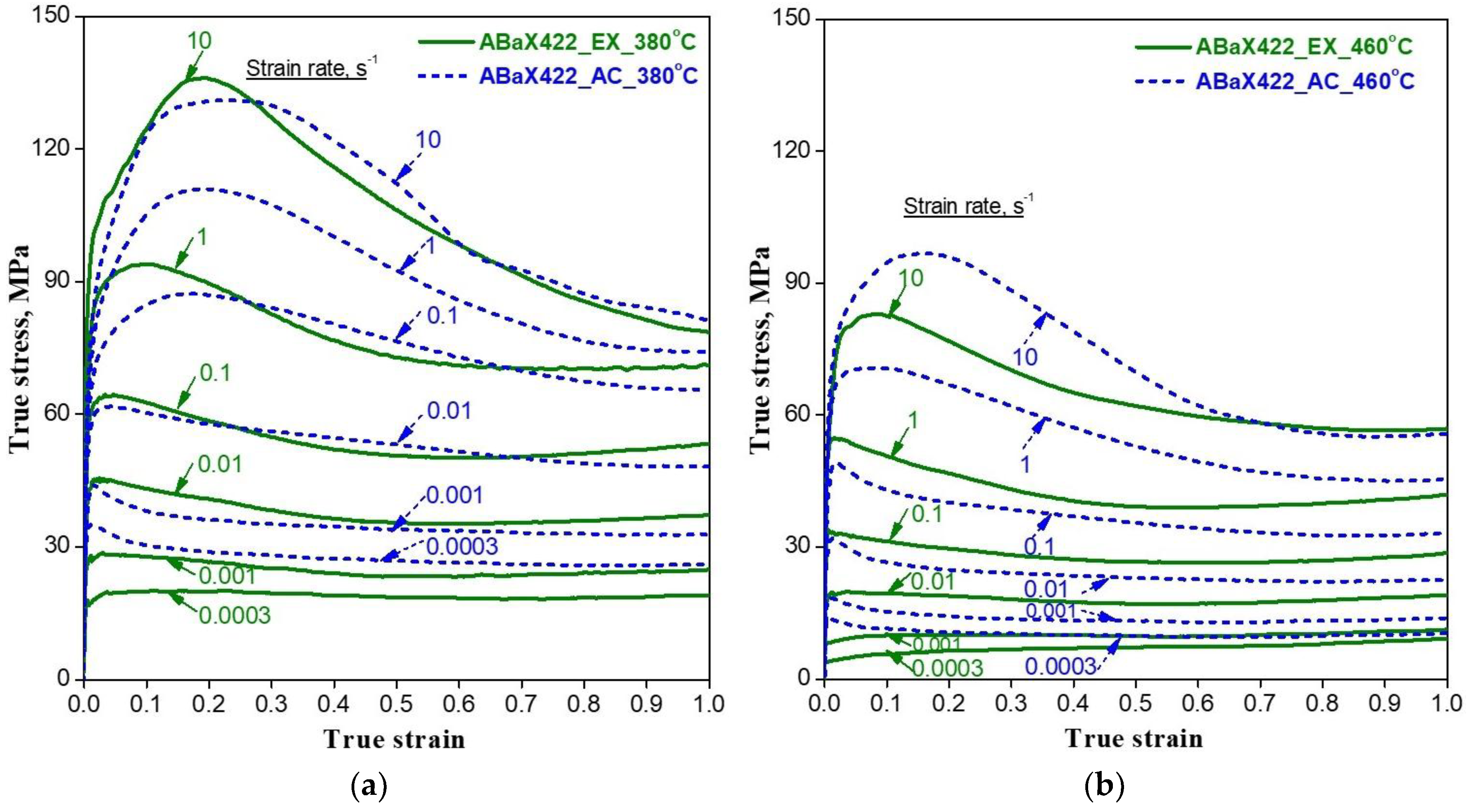
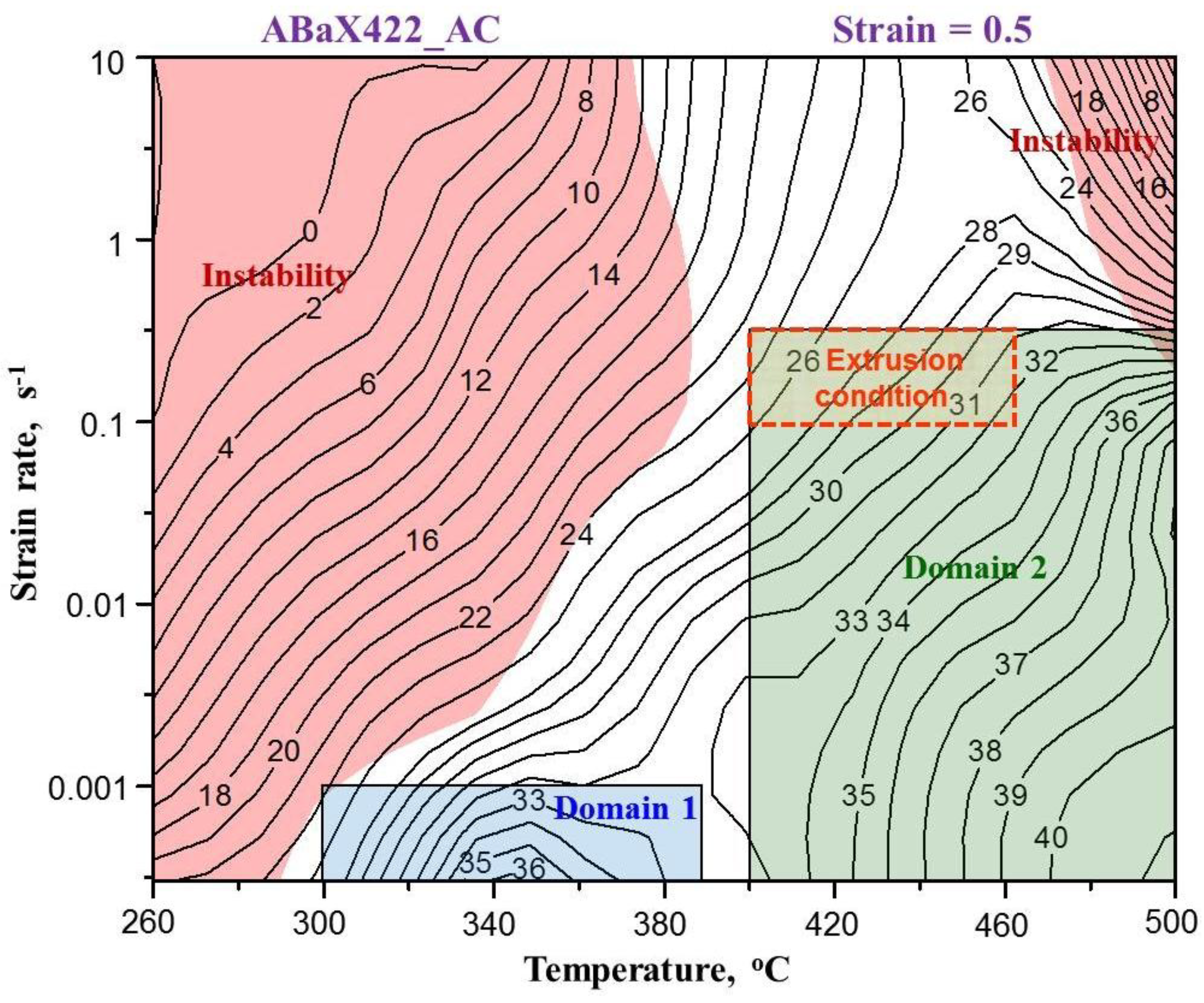
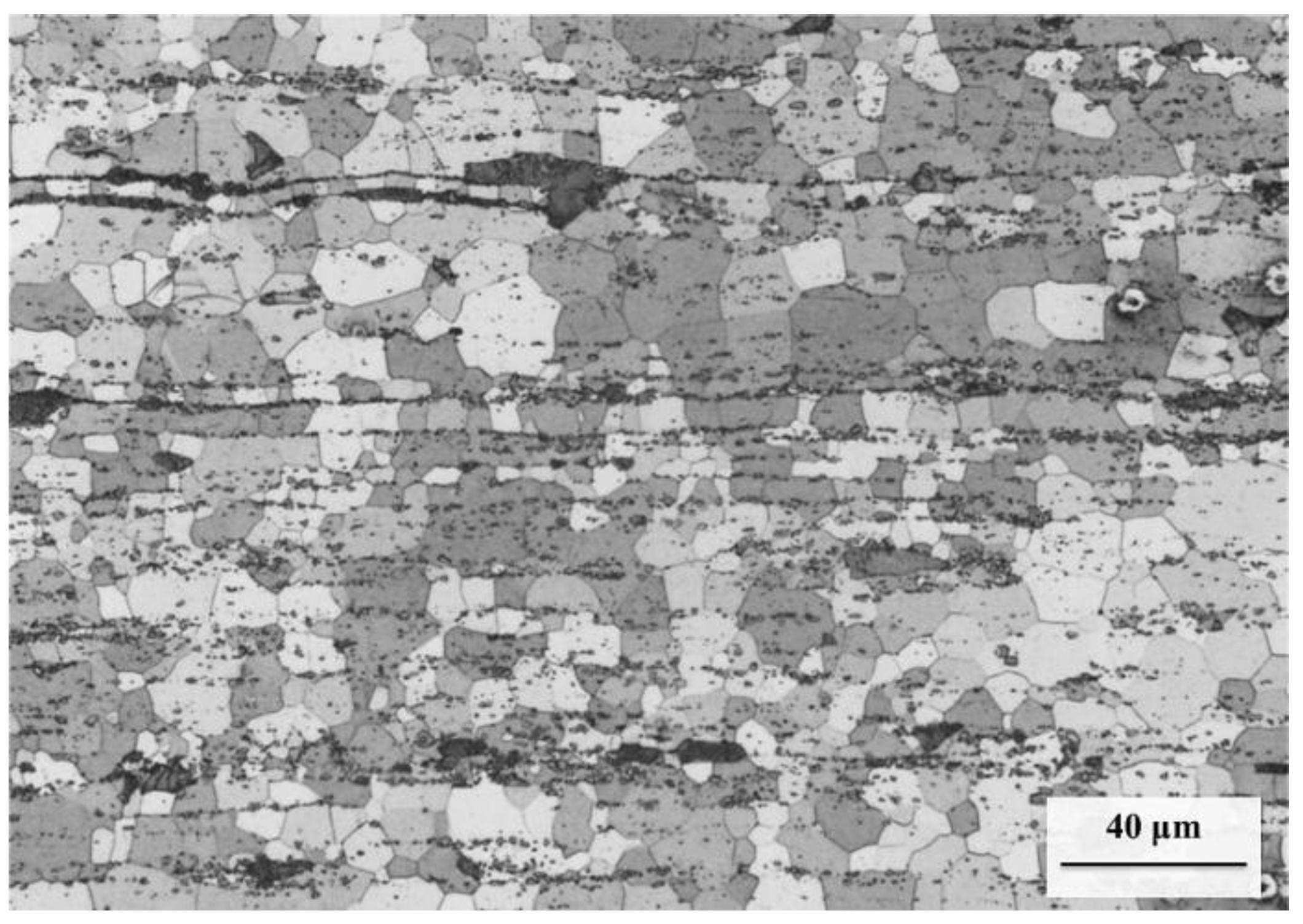


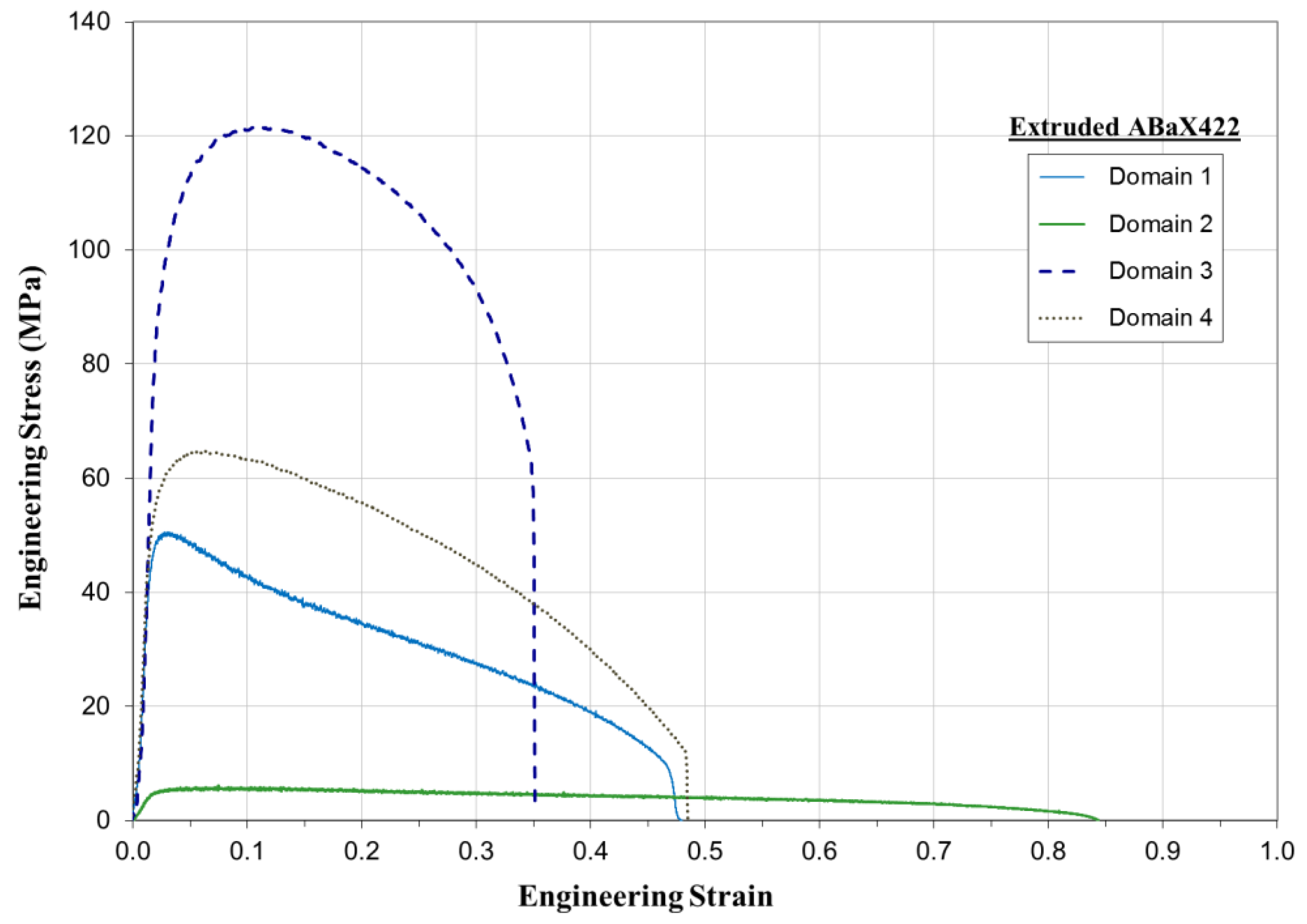
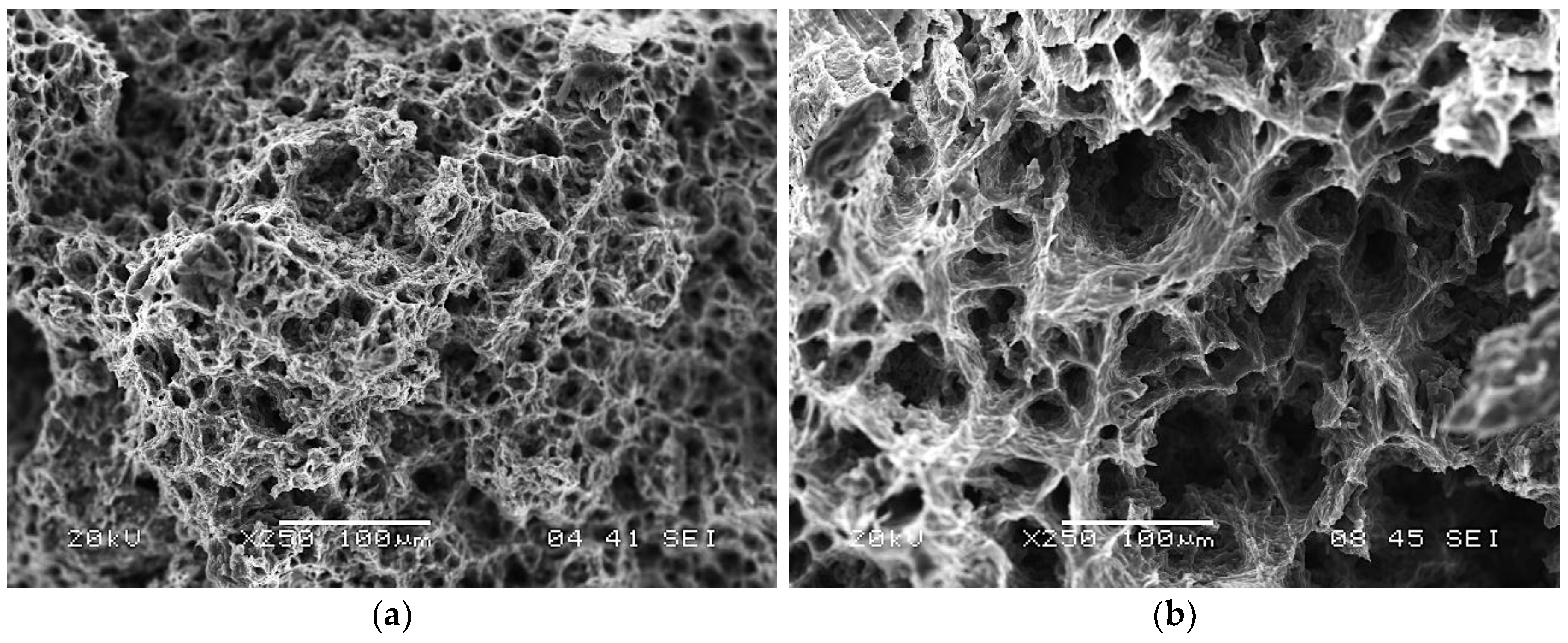
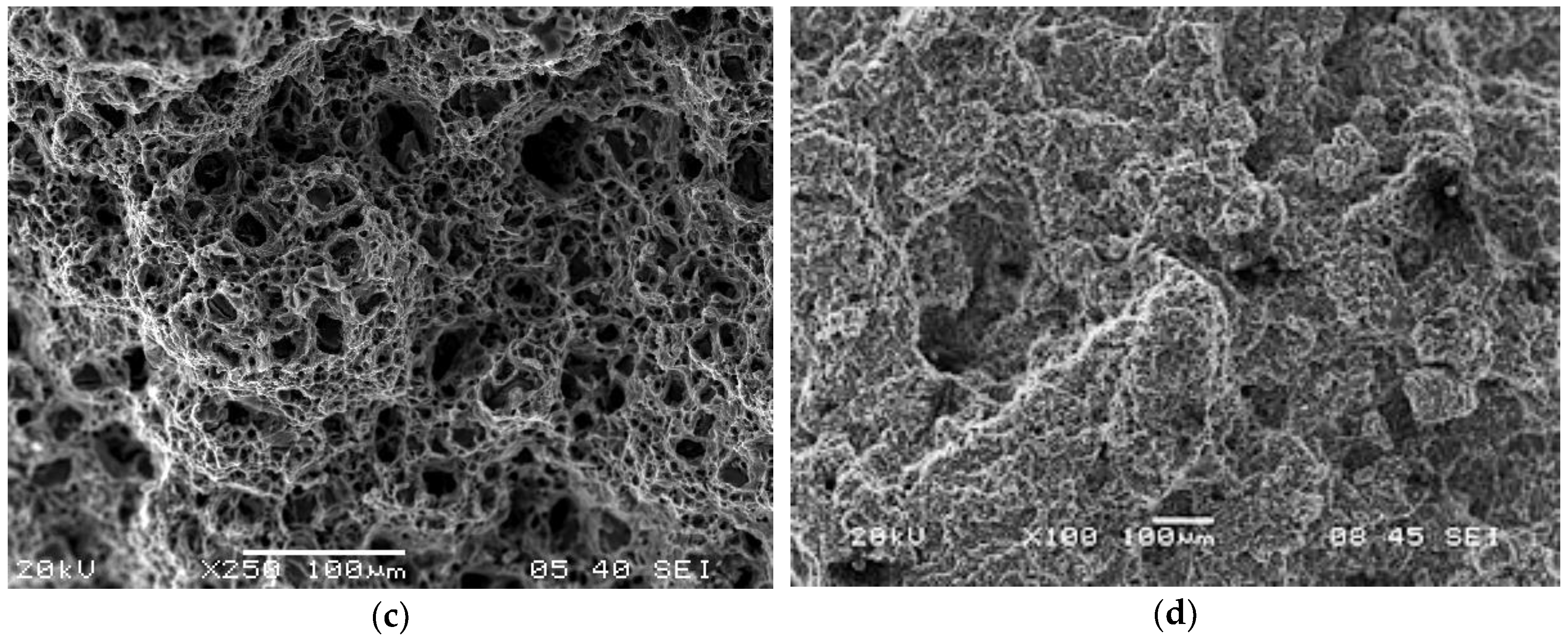
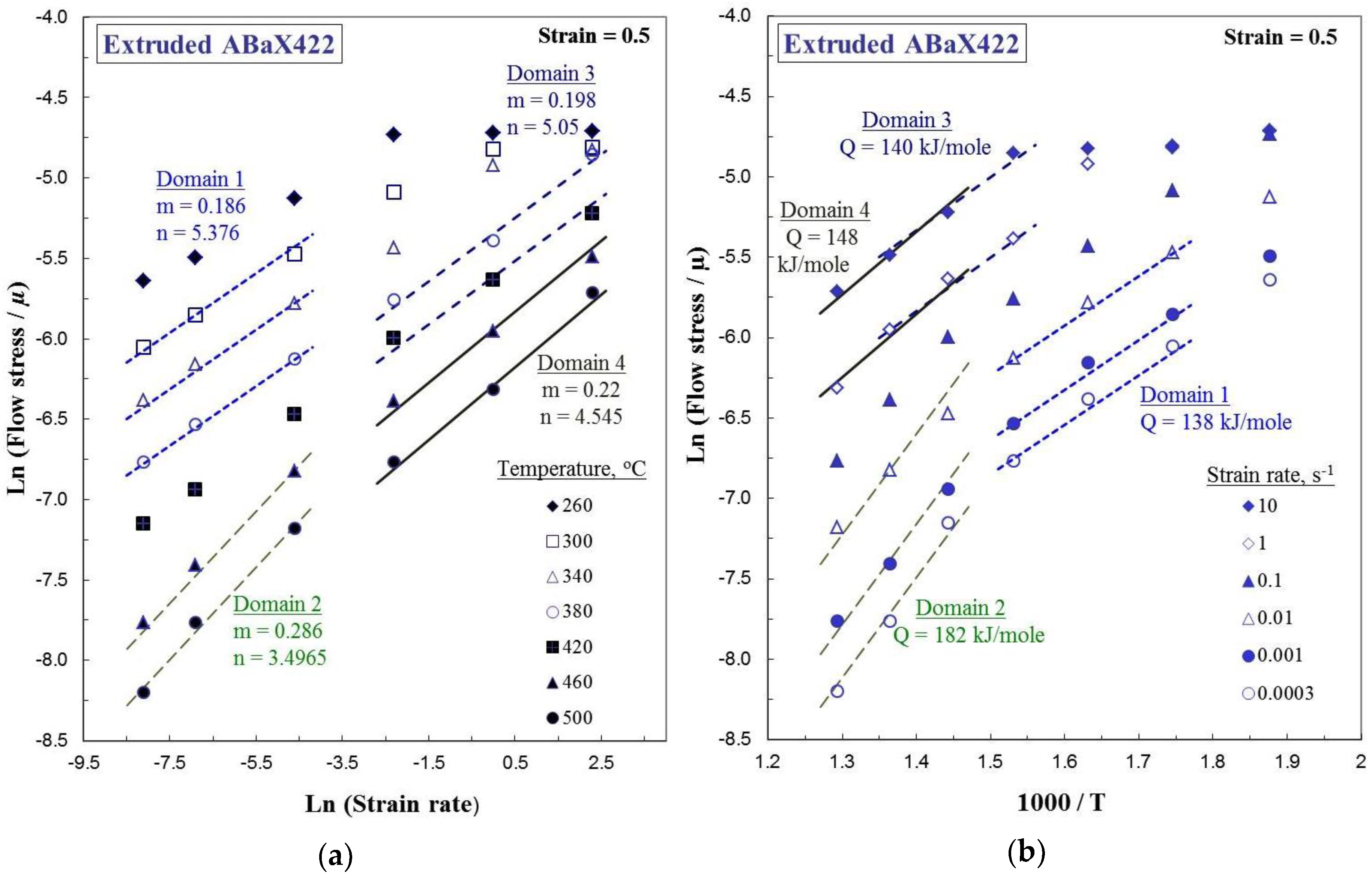

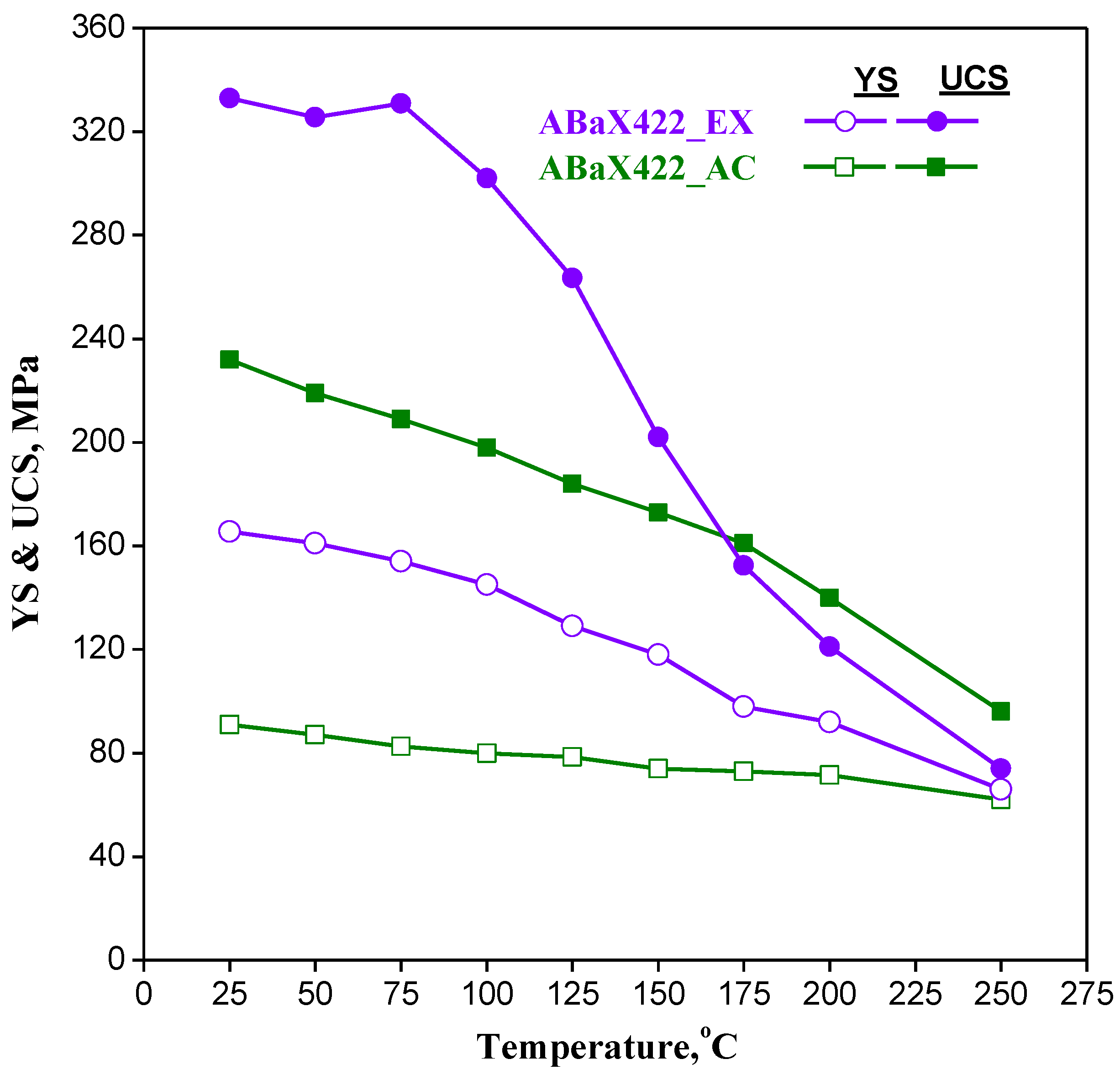
| Condition | Yield Strength (MPa) | Ultimate Tensile Strength (UTS), MPa | Strain to Fracture | Maximum Displacement (mm) | % Elongation |
|---|---|---|---|---|---|
| Domain 1 (380 °C and 0.0003 s−1) | 41 | 50 | 0.47 | 19.25 | 47% |
| Domain 2 (500 °C and 0.0003 s−1) | 2 | 6 | 0.82 | 32.89 | 84% |
| Domain 3 (380 °C/2.3 s−1) | 80 | 121 | 0.35 | 17.61 | 35% |
| Domain 4 (500 °C/2.3 s−1) | 50 | 64 | 0.49 | 19.64 | 48% |
| Domain # | As-Cast (Ref. [13]) | Extruded | ||||
|---|---|---|---|---|---|---|
| n | Q (kJ/mole) | Mechanism | n | Q (kJ/mole) | Mechanism | |
| 1 | 5.24 | 169 | Climb (LSD) | 5.37 | 138 | Climb (LSD) |
| 2 | 4.46 | 263 | Cross-slip | 3.49 | 182 | Cross-slip |
| 3 | - | - | - | 5.05 | 140 | Climb (GSD) |
| 4 | - | - | - | 4.54 | 148 | GB cracking |
© 2018 by the authors. Licensee MDPI, Basel, Switzerland. This article is an open access article distributed under the terms and conditions of the Creative Commons Attribution (CC BY) license (http://creativecommons.org/licenses/by/4.0/).
Share and Cite
Rao, K.P.; Chalasani, D.; Suresh, K.; Prasad, Y.V.R.K.; Dieringa, H.; Hort, N. Connected Process Design for Hot Working of a Creep-Resistant Mg–4Al–2Ba–2Ca Alloy (ABaX422). Metals 2018, 8, 463. https://doi.org/10.3390/met8060463
Rao KP, Chalasani D, Suresh K, Prasad YVRK, Dieringa H, Hort N. Connected Process Design for Hot Working of a Creep-Resistant Mg–4Al–2Ba–2Ca Alloy (ABaX422). Metals. 2018; 8(6):463. https://doi.org/10.3390/met8060463
Chicago/Turabian StyleRao, Kamineni Pitcheswara, Dharmendra Chalasani, Kalidass Suresh, Yellapregada Venkata Rama Krishna Prasad, Hajo Dieringa, and Norbert Hort. 2018. "Connected Process Design for Hot Working of a Creep-Resistant Mg–4Al–2Ba–2Ca Alloy (ABaX422)" Metals 8, no. 6: 463. https://doi.org/10.3390/met8060463





